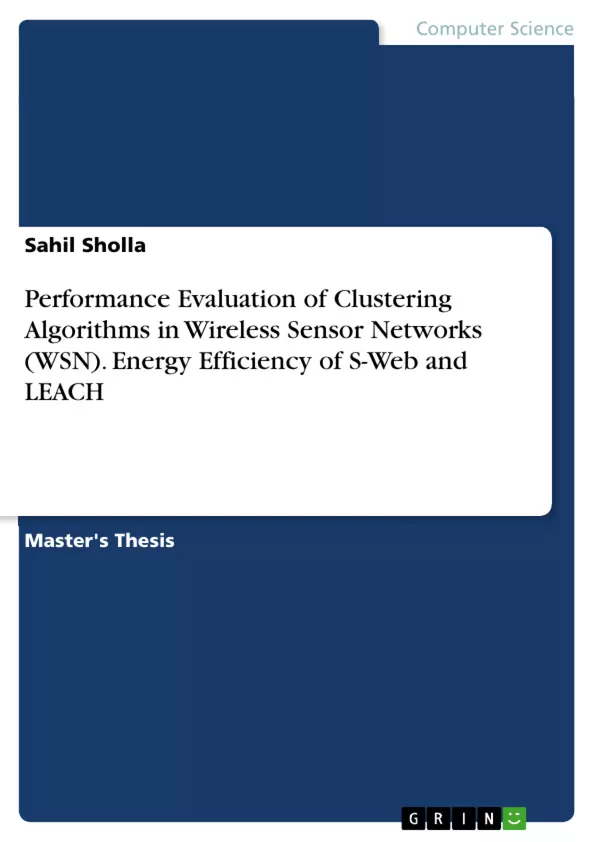Wireless Sensor Networks (WSNs) are highly integrated technologies applying sensors, microcontrollers and wireless networks technologies. Wireless sensor networks (WSNs) is a promising technology that has a large spectrum of applications such as, battlefield reconnaissance, border protection and security surveillance, preparing forecasts, severe environment detection, volcano monitoring, disaster management. WSNs operate unattended in harsh environments with limited energy supplies that can’t be practically changed or recharged. Thus energy efficiency is a critical design issue which must be addressed.
Clustering plays an effective role in judicious use of dwindling energy resources of the deployed sensor nodes. Nodes are grouped into clusters and a specific designated node, called the cluster head is responsible for collecting data from the nodes in its cluster, aggregating them and sending to the BS, where data can be retrieved later. Besides energy efficiency, clustering has many other advantages like reduced routing overhead, conservation of communication bandwidth, stabilized network topology, network stability etc
In this research, we study the energy efficiency of two clustering algorithms, S-Web and LEACH and compare them for network lifetime. Simulation results show that the S-Web clustering mechanism achieves a noticeable improvement in the network lifetime.
Inhaltsverzeichnis (Table of Contents)
- CHAPTER 1
- INTRODUCTION
- CHAPTER 2
- LITERATURE SURVEY
- Clustering ad hoc networks
- Advantages of Clustering
- Challenges for Clustering Algorithms
- Clustering Schemes for Sensor Networks
- Optimizing Cluster Organization
- Averaging Power Consumption
- Scheduling Active and Non-Active Nodes
- Clustering Algorithms
- Low-Energy Adaptive Clustering Hierarchy (LEACH)
- Sensor Web or S-WEB
- Energy Efficient Clustering Scheme (EECS)
- Hybrid Energy Efficient Distributed Clustering (HEED)
- Energy-efficient unequal clustering (EEUC)
- Power-efficient and adaptive clustering hierarchy (PEACH)
- Problem Definition and Implementation
- Problem Definition
- Implementation
- Results
- First scenario (Normal Node to Normal Node)
- Second scenario (Normal Node to Cluster Head)
- Third scenario (Cluster Head to Normal Node)
- Fourth scenario (Cluster Head to Cluster Head)
- Fifth scenario (Random)
Zielsetzung und Themenschwerpunkte (Objectives and Key Themes)
This thesis aims to evaluate the energy efficiency of two clustering algorithms, S-Web and LEACH, in wireless sensor networks (WSNs). The main objective is to compare the performance of these algorithms in terms of network lifetime, a crucial factor for WSNs operating in energy-constrained environments. The key themes explored in this research are:- Energy efficiency in WSNs
- Clustering algorithms for WSNs
- Performance evaluation of clustering algorithms
- Network lifetime analysis
- S-Web and LEACH clustering algorithms
Zusammenfassung der Kapitel (Chapter Summaries)
Chapter 1: Introduction
This chapter introduces the concept of Wireless Sensor Networks (WSNs) and highlights their widespread applications in various fields, including battlefield reconnaissance, border security, environmental monitoring, and disaster management. The chapter emphasizes the critical importance of energy efficiency in WSNs due to their often remote and unattended operation.Chapter 2: Literature Survey
This chapter provides an extensive overview of clustering techniques for wireless ad hoc networks. It explores the advantages of clustering, including enhanced energy efficiency, reduced routing overhead, and improved network stability. The chapter also discusses the challenges associated with clustering algorithms, such as energy limitations, resource constraints, and ensuring secure communication. It then delves into various clustering schemes designed for sensor networks, focusing on approaches for optimizing cluster organization, averaging power consumption, and scheduling active and inactive nodes. Finally, the chapter examines several prominent clustering algorithms including LEACH, S-WEB, EECS, HEED, EEUC, and PEACH.Chapter 3: Problem Definition and Implementation
This chapter presents the specific problem investigated in this research: evaluating the energy efficiency of S-Web and LEACH clustering algorithms in WSNs. It outlines the implementation details, including the simulation environment and the metrics used for performance evaluation.Chapter 4: Results
This chapter presents the results of the simulation experiments conducted to compare the performance of S-Web and LEACH algorithms. The results are analyzed based on different scenarios, considering various factors such as communication distances and node roles. The chapter provides detailed insights into the energy efficiency of each algorithm and their impact on network lifetime.Schlüsselwörter (Keywords)
The research revolves around the critical concepts of energy efficiency and clustering in Wireless Sensor Networks (WSNs). The key keywords encapsulate the central themes of the study, including: Clustering, Energy Efficiency, SWEB, Wireless Sensor Networks, LEACH, and Network Lifetime.- Citar trabajo
- Sahil Sholla (Autor), 2013, Performance Evaluation of Clustering Algorithms in Wireless Sensor Networks (WSN). Energy Efficiency of S-Web and LEACH, Múnich, GRIN Verlag, https://www.grin.com/document/293888



